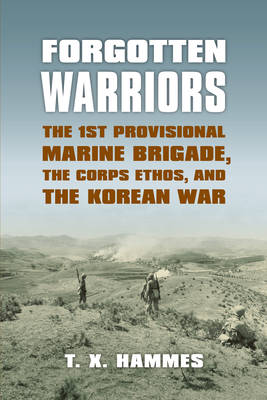
- Afhalen na 1 uur in een winkel met voorraad
- Gratis thuislevering in België vanaf € 30
- Ruim aanbod met 7 miljoen producten
- Afhalen na 1 uur in een winkel met voorraad
- Gratis thuislevering in België vanaf € 30
- Ruim aanbod met 7 miljoen producten
Zoeken
Forgotten Warriors
The 1st Provisional Marine Brigade, the Corps Ethos, and the Korean War
T X Hammes
€ 50,45
+ 100 punten
Uitvoering
Omschrijving
When the Korean War broke out in 1950, the Marine Corps was ordered to deploy an air-ground brigade in less than ten days, even though no such brigade existed at the time. Assembled from the woefully understrength 1st Marine Division and 1st Marine Air Wing units, the Brigade shipped out only six days after activation, sailed directly to Korea, was in combat within ninety-six hours of landing and, despite these enormous handicaps and numerically superior enemy forces, won every one of its engagements and helped secure the Pusan Perimeter. Despite its remarkable achievements, the Brigade's history has largely been lost amid accounts of the sweeping operations that followed. Its real history has been replaced by myths that attribute its success to tough training, great conditioning, unit cohesion, and combat-experienced officers. None of which were true. T. X. Hammes now reveals the real story of the Brigade's success, prominently citing the Corps' crucial ability to maintain its ethos, culture, and combat effectiveness during the period between World War II and Korea, when its very existence was being challenged. By studying the Corps from 1945 to 1950, Hammes shows that it was indeed the culture of the Corps-a culture based on remembering its storied history and learning to face modern challenges-that was responsible for the Brigade's success. The Corps remembered the human factors that made it so successful in past wars, notably the ethos of never leaving another marine behind. At the same time, the Corps demonstrated commendable flexibility in adapting its doctrine and operations to evolutions in modern warfare. In particular, the Corps overcame the air-ground schism that marked the end of World War II to excel at close air support. Despite massive budget and manpower cuts, the Corps continued to experiment and learn even at it clung to its historical lodestones. This approach was validated during the Brigade's trial by fire. More than a mere battle history, Forgotten Warriors gets to the heart of marine culture to show fighting forces have to both remember and learn. As today's armed forces face similar challenges, this book confirms that culture as much as technology prepares America's fighting men and women to answer their country's call.
Specificaties
Betrokkenen
- Auteur(s):
- Uitgeverij:
Inhoud
- Aantal bladzijden:
- 274
- Taal:
- Engels
- Reeks:
Eigenschappen
- Productcode (EAN):
- 9780700617326
- Verschijningsdatum:
- 1/09/2010
- Uitvoering:
- Hardcover
- Formaat:
- Genaaid
- Afmetingen:
- 160 mm x 234 mm
- Gewicht:
- 566 g

Alleen bij Standaard Boekhandel
+ 100 punten op je klantenkaart van Standaard Boekhandel
Beoordelingen
We publiceren alleen reviews die voldoen aan de voorwaarden voor reviews. Bekijk onze voorwaarden voor reviews.











